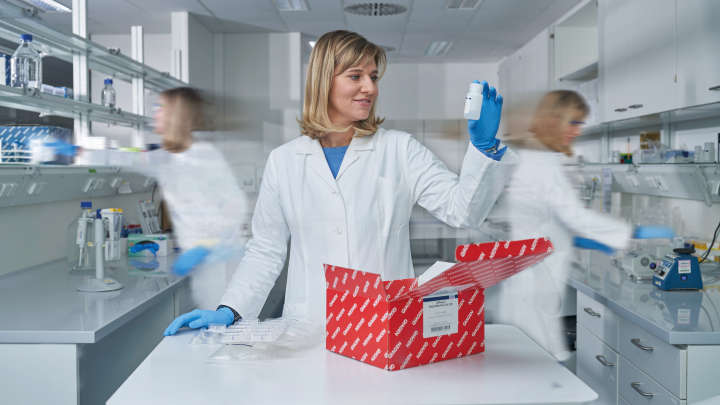✓ オンライン注文による24時間年中無休の自動処理システム
✓ 知識豊富で専門的な製品&テクニカルサポート
✓ 迅速で信頼性の高い(再)注文
QIAcuity Nanoplate 26k 8-well (10)
カタログ番号 / ID. 250031
✓ オンライン注文による24時間年中無休の自動処理システム
✓ 知識豊富で専門的な製品&テクニカルサポート
✓ 迅速で信頼性の高い(再)注文
特徴
- さまざまなアプリケーションのニーズに対応した4種類のナノプレート
- 1ウェルあたり8500分画または26,000分画
- SBS規格に準拠
製品詳細
QIAcuity NanoplatesはデジタルPCR用のマイクロ流体プレートです。1ウェルあたりの分画数は8,500または26,000で最大8サンプル、24サンプルまたは96サンプルを処理できます。4種類のナノプレートはすべて、QIAcuity Digital PCR Systemでの使用を想定して設計されています。
これらのナノプレートは、QIAcuity Digital PCR Systemでのみ使用できます。QIAgilityを使用してQIAcuity Nanoplatesにおける液体の取り扱いとPCRセットアップを自動化するには、専用のQIAcuity Nanoplate Adapterをご使用ください。アダプターを取り付け後、QIAcuity Digital PCR SystemにプレートをロードしてdPCRを実施します。
製品について詳しくお知りになりたい場合は、弊社のdPCRスペシャリストより連絡を差し上げますので、こちらからサインインしてください。
パフォーマンス
QIAcuity装置によるデジタルPCR用に特別に設計されたプレートです。アプリケーションの用途に応じた仕様を満たし、SBS規格に準拠した4種類のナノプレートを提供しています。
| タイプ | フレームカラー | 仕様 | アプリケーション |
| Nanoplate 26K 8-well | ライトブルー |
8ウェル、約26,000分画 1ウェルあたり容量 40 µl |
希少突然変異検出、 リキッドバイオプシー、遺伝子 発現解析、 病原体検出等 |
| Nanoplate 26K 24-well | ブルー |
24ウェル、約26,000分画 1ウェルあたり容量 40 µl |
希少突然変異検出、 リキッドバイオプシー、遺伝子 発現解析、 病原体検出 等 |
| Nanoplate 8.5K 24-well | ホワイト |
24ウェル、約8,500分画 1ウェルあたり容量 12 µl |
コピー数多型解析、 遺伝子発現解析、 NGSライブラリー定量、 ゲノム編集 検出等 |
| Nanoplate 8.5K 96-well | グレー |
96ウェル、約8,500分画 1ウェルあたり容量 12 µl |
原理
分注およびロード、実験、結果解析というわずか3つのステップで、2時間以内にdPCRの結果が得られます。ナノプレートでのdPCRの原理はこちらで説明しています。
操作手順
qPCR実験と同様に、サンプル調製では、マスターミックス、プローブ、プライマーを8、24または96ウェルナノプレートに加え、その後サンプルを加えます。このシステムは、パーティショニング、サーマルサイクル、イメージングを1つに統合した完全自動化装置です。サンプルから結果まで2時間未満で完了します。Software Suiteは、ターゲット配列のマイクロリットルあたりのコピー数で濃度を提供するだけでなく、陽性サンプルやNTCなどの品質コントロールも解析できます。この解析は、同じローカルエリアネットワーク(Local Area Network、LAN)内の離れた場所にあるコンピューターでも行うことができます。
アプリケーション
QIAcuity Nanoplatesは、QIAcuityデジタルPCRシステムおよびQIAcuity PCRキットと組み合わせて、次のデジタルPCRアプリケーションに利用できます。
- 希少突然変異の検出
- コピー数多型解析
- 遺伝子発現解析
- 病原体検出
- 遺伝子型決定
- miRNA研究
- 遺伝子細胞治療
- 残留DNA定量
- 排水モニタリング

